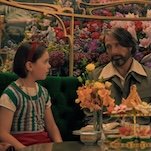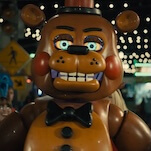Heroes on trial: 16 superhero court cases

1. Superman’s trial (Action Comics #716-#717, Adventures Of Superman #529-#531, Superman Vol. 2 #106-#108, Superman: The Man Of Steel #50-#52, Superman: The Man Of Tomorrow #3)
Whether Zack Snyder’s Man Of Steel, the latest cinematic adventure of the Last Son Of Krypton, succeeds or fails as a film, the trailer has already provided moviegoers with several instantly iconic images, among them a shot which immediately earned an upgrade to appear on one of the movie posters: Superman in custody. The idea of a superhero being hauled away in handcuffs may seem improbable to those who don’t read comic books, but costumed crimefighters find themselves on the wrong side of the law on a surprisingly frequent basis, with Superman in particular having turned up in numerous courtrooms since debuting in the pages of Action Comics in 1938. The most notable of his trials, however, took place, not on his adopted home planet of Earth, but in another galaxy altogether. After fighting a long, hard battle against the Parasite, a weakened Superman was arrested, shackled, and hauled in front of a trio of blue-skinned aliens calling themselves The Tribunal, where he was held responsible for the actions of one of his distant, long dead Kryptonian relatives and sentenced to death. With the help of Superboy, Supergirl, Steel, Alpha Centurion, and the Eradicator—and despite the best efforts of Hank Henshaw, better known as Cyborg Superman, to stop him—Superman managed to escape his imprisonment and return to Earth. Though one of his fellow prisoners, a creature named Mope, sacrificed himself in order to trick The Tribunal into believing that they had successfully carried out their sentence against Superman.
2. Reed Richards’ trial (Fantastic Four #261-#262)
Despite having a notoriously big brain, Reed Richards of the Fantastic Four decided it would be just and fair to save the life of Galactus, the cosmic entity widely known for his insatiable appetite for planets. But when Galactus turns around and starts eating planets again, the survivors of some of those planets—including some understandably angry Skrulls, whose entire Throneworld was destroyed—decide to take Richards to task. Narrowly skirting immediate execution thanks to the intervention of Uatu the Watcher, the man known as Mister Fantastic is put on trial, with Princess Lilandra of the Shi’ar Empire serving as prosecutor. Richards argues that he saved Galactus’ life because forces of nature need to be preserved, and no less an authority than Odin shows up to lend credence to this theory. Yet it takes the summoning of Eternity, who links the minds of all in attendance and imparts them with the Cosmic Truth that Galactus must exist, for Richards to be begrudgingly cleared of all charges.
3. The Flash’s trial (The Flash Vol. 2 #323-#350)
The Flash isn’t generally thought of as being one of DC’s darker heroes, but Barry Allen’s personal life hit some truly none-more-black moments during the last few years of his series’ original run, the first occurring when Eobard Thawne—otherwise known as Professor Zoom, the Reverse-Flash—seemingly made him a widower. Although it was later revealed that Iris West Allen wasn’t actually dead, Barry believed her to be so, and after a suitable number of issues of mourning, the Central City police scientist found solace in the arms of Fiona Webb, to whom he was soon engaged. Just before the couple arrived at the altar to say “I do,” however, Thawne made an attempt on Fiona’s life as well, spurring Barry to suit up and literally speed around the world and into outer space to prevent the loss of another love. While the Flash’s efforts to save his fiancée were successful, he accidentally broke Thawne’s neck in the process, killing him. Willingly acknowledging his actions, the Flash allowed himself to be placed under arrest (although he was quickly released on his own recognizance) and was put on trial for murder. Initially found guilty as a result of the jury being under the sway of despicable 64th-century magician Abra Kadabra, the Flash was eventually cleared of all charges.
4. Daredevil gets sued (Daredevil Vol. 2 #20-#25)
Matt Murdock’s secret identity as Daredevil constantly puts his legal ethics as an attorney in question, and he severely abuses the law when he takes on a case suing Daredevil for property damage. After a wealthy philanthropist tells Murdock that his alter ego is responsible for destroying his greenhouse, the lawyer takes the case so that he can have access to information that will help him catch the Daredevil imposter. At a time when Daredevil comics were exceedingly bleak, Back To The Future co-writer Bob Gale arrived to deliver a story that would be at home in the Silver Age. From the Jester serving Daredevil his subpoena to the final reveal of a villain with a pencil-thin mustache asking for a good twirling, Gale’s story shows the lighter side of a superhero’s legal battles. And as if his own lies weren’t enough, Murdock gets his friends involved in some super-perjury along the way, asking Peter Parker to put on the Daredevil costume so that he can share a courtroom with his superhero identity.
5. America vs. the Justice Society (America Vs. The Justice Society #1-#4)
In one of the final Earth-Two tales DC told before wreaking havoc on its multiverse with Crisis On Infinite Earths, the integrity of the Justice Society Of America was called into question in the wake of the discovery of a diary in which Batman—who had died several years earlier on Earth-Two—repeatedly accused the JSA of committing acts of treason against the United States. Reminiscent of the oft-cited incident during the Red Scare—when the JSA opted to retire rather than agree to the demands of the House Un-American Activities Committee and reveal their secret identities to the government—the Justice Society’s entire history is questioned and discussed in exhaustive detail in open court. This storyline provided writer Roy Thomas with the opportunity to run through numerous nearly forgotten JSA cases from the Golden Age of the group. The charges against the group were dropped after it came to light that Batman had penned the fake diary in an effort to steer the JSA toward stopping an attack by time-traveling villain Per Degaton, but the victory proved pyrrhic, as the aforementioned Crisis wiped the Earth-Two Batman out of existence within a few short months, thereby completely negating the events of America Vs. The Justice Society.
6. Starfox’s trial (She-Hulk Vol. 2 #6-7)
The legal misadventures of Jennifer “She-Hulk” Walters have made her solo series some of the most entertaining superhero humor comics ever published, but writer Dan Slott tackles more serious subject matter when he puts amorous space-god Starfox on the stand for sexual assault. A former Avenger with the power to persuade others by mentally controlling the pleasure centers of their brains, Starfox is brought to court when a married mother of three wakes up in bed with him. Eros of Titan is at one point described as “a walking roofie” by the law firm’s meta librarian, who doesn’t want to read about a character like that in his comic books. (In Slott’s She-Hulk, comics are valuable research tools and help establish precedent in court.) Starfox’s trial is one of She-Hulk’s most turbulent cases, starting on Earth, where she wonders if Starfox used his power on her during their time as Avengers, and ending in space, where it’s revealed that the hero’s recent behavior is a result of his brother Thanos’ manipulations. Yet despite She-Hulk’s affair with Eros being completely of her own will, that doesn’t stop her from kicking him in the junk when he gets out of line.
7. Batman’s trial (“Trial,” Batman: The Animated Series)
Batman has had to make some tough escapes in the past, but relying on a vigilante-hating lawyer to get him out of Arkham Asylum has its own unique challenges. Trapped in a straitjacket and put on trial for creating the lunatic personalities that form his rogues gallery, the Dark Knight’s only hope lies in District Attorney Janet Van Dorn, who agrees with the bad guys until she actually spends time with them. She changes her initial opinion that Batman is “a drug the city keeps taking to avoid facing reality” after her cross-examinations, which reveal each villain’s deep-rooted mental illness and how Batman is required to keep them in check. He’s capable of doing what the police can’t, and that’s what Gotham City needs if it’s going to survive a wave of threats from people that don’t adhere to any sort of typical criminal behavior. Van Dorn makes such an impassioned closing argument for the hero that she actually convinces the jury of costumed criminals to deliver a “not guilty” verdict, proving that even Batman’s greatest enemies understand he’s doing the world a service.
8. White Tiger’s trial (Daredevil Vol. 2 #38-#40)
Sometimes superhero trials end very badly. Volatile personalities and enhanced physical abilities in a high-stress environment can be a disastrous combination, and Matt Murdock learns that the hard way when he represents Hector Ayala, a vigilante by the name of White Tiger. A victim of being in the wrong place at the wrong time, Ayala is falsely accused of murdering a police officer after he stops a robbery, and his Heroes For Hire teammates turn to Murdock to clear their friend’s name. This comes at a time when Murdock is fighting public accusations that he is Daredevil, and he’s greeted with hostility from the judge and the prosecuting lawyer, who is on a mission to reveal the hidden menace of superheroes. With a wife who is desperate for a divorce and a no leads on the actual killer, Murdock has the cards stacked against him, and even an A-list lineup of superhero witnesses can’t prevent the jury from delivering a guilty verdict. Refusing to go to prison for a crime he didn’t commit, Ayala flees and is gunned down by the police on the courthouse steps, ultimately making a bolder statement than any lawyer could.








































